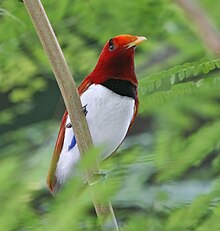
A passerine is any bird of the order Passeriformes, which includes more than half of all bird species. Sometimes known as perching birds, passerines generally have an anisodactyl arrangement of their toes, which facilitates perching.
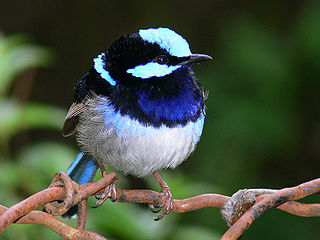
The Australasian wrens are a family, Maluridae, of small, insectivorous passerine birds endemic to Australia and New Guinea. While commonly known as wrens, they are unrelated to the true wrens. The family comprises 32 species in six genera.
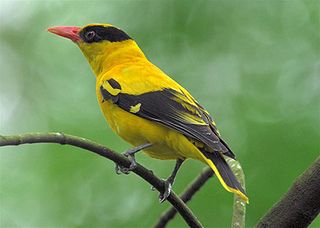
The Old World orioles (Oriolidae) are an Old World family of passerine birds. The family contains 41 species which are divided in 4 genera. The family includes two extinct species from New Zealand that are placed in the genus Turnagra.

Ovenbirds or furnariids are a large family of small suboscine passerine birds found from Mexico and Central to southern South America. They form the family Furnariidae. This is a large family containing around 315 species and 70 genera. The ovenbird, which breeds in North America, is not a furnariid – rather it is a distantly related bird of the wood warbler family, Parulidae.

The woodcreepers (Dendrocolaptinae) comprise a subfamily of suboscine passerine birds endemic to the Neotropics. They have traditionally been considered a distinct family Dendrocolaptidae, but most authorities now place them as a subfamily of the ovenbirds (Furnariidae). They superficially resemble the Old World treecreepers, but they are unrelated and the similarities are due to convergent evolution. The subfamily contains 63 species in 16 genera.

The white-eyes are a family, Zosteropidae, of small passerine birds native to tropical, subtropical and temperate Sub-Saharan Africa, southern and eastern Asia, and Australasia. White-eyes inhabit most tropical islands in the Indian Ocean, the western Pacific Ocean, and the Gulf of Guinea. Discounting some widespread members of the genus Zosterops, most species are endemic to single islands or archipelagos. The silvereye, Zosterops lateralis, naturally colonised New Zealand, where it is known as the "wax-eye" or tauhou ("stranger"), from 1855. The silvereye has also been introduced to the Society Islands in French Polynesia, while the Japanese white-eye has been introduced to Hawaii.

Psophodidae is a family of passerine birds native to Australia and nearby areas. It has a complicated taxonomic history and different authors vary in which birds they include in the family. In the strictest sense, it includes only the five or six species of whipbirds and wedgebills, but some authors also include the quail-thrushes (Cinclosoma), eight species of ground-dwelling birds found in Australia and New Guinea, and the jewel-babblers (Ptilorrhoa), three or four species found in rainforest in New Guinea. Others place them in their own family, the Cinclosomatidae. The Malaysian rail-babbler was formerly sometimes placed in this family, which would then be called Eupetidae.

Anthochaera is a genus of birds in the honeyeater family. The species are endemic to Australia and include the little wattlebird, the red wattlebird, the western wattlebird, and the yellow wattlebird. A molecular phylogenetic study has shown that the regent honeyeater also belongs in this genus.

The blue-capped ifrit, also known as the blue-capped ifrita, is a small and insectivorous passerine species currently placed in the monotypic family, Ifritidae. Previously, the ifrit has been placed in a plethora of families including Cinclosomatidae or Monarchidae. Blue-capped ifrits are considered an ancient relict species endemic to New Guinea. This corvoid species originally dates back to the Oligocene epoch, on a series of proto-Papuan islands, with minimal known evolutionary divergences.

Passerida is, under the Sibley-Ahlquist taxonomy, one of two parvorders contained within the suborder Passeri. While more recent research suggests that its sister parvorder, Corvida, is not a monophyletic grouping, the Passerida as a distinct clade are widely accepted.

Stenostiridae, or the fairy flycatchers, are a family of small passerine birds proposed as a result of recent discoveries in molecular systematics. They are also referred to as stenostirid warblers.

The striated thornbill is a species of bird in the family Acanthizidae. It is endemic to Australia, where its natural habitat is subtropical or tropical dry forests.

The scrubtit is a species of bird in the thornbill family Acanthizidae. It is endemic to Tasmania and King Island in Australia. Its natural habitat is the temperate rainforest, Nothofagus beech forest and eucalypt woodland. It is a small species that resembles the Sericornis scrubwrens.
Coracornis is a genus of birds in the family Pachycephalidae. The two species are found in Indonesia.
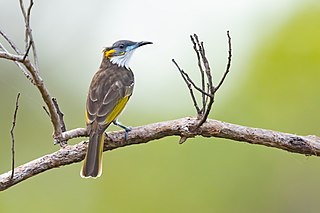
The white-streaked honeyeater is a species of bird in the family Meliphagidae. It is monotypic within the genus Trichodere. It is endemic to Cape York Peninsula. Its natural habitat is subtropical or tropical dry forest.

Malaconotoidea is a superfamily of passerine birds. They contain a vast diversity of omnivorous and carnivorous songbirds widespread in Africa and Australia, many of which superficially resemble shrikes. It was defined and named by Cacraft and colleagues in 2004 and contains the bushshrikes (Malaconotidae), helmetshrikes (Prionopidae), ioras (Aegithinidae), vangas (Vangidae) and the Australian butcherbirds, magpies, currawongs and woodswallows (Artamidae). Molecular analysis in 2006 added the Bornean bristlehead to the group, though its position in the Malconotoidea is unclear. It was initially thought related to the butcherbirds and woodswallows but now is thought to be an early offshoot.

Kurrartapu johnnguyeni is an extinct species of bird in the Australian magpie and butcherbird family. It was described from Early Miocene material found at Riversleigh in north-western Queensland, Australia. It is the first Tertiary record of a cracticid from Australia. The size of the fossil material indicates that it was similar in size to the living black butcherbird. The generic name is a Kalkatungu language term for the Australian magpie. The specific epithet honours John Nguyen, the father of the senior describer.
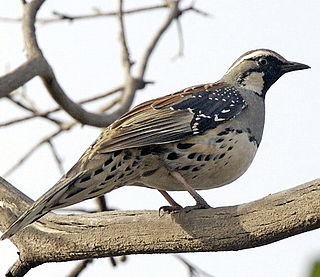
Cinclosomatidae is a family of passerine birds native to Australia and New Guinea. It has a complicated taxonomic history and different authors vary in which birds they include in the family. It includes the quail-thrushes and jewel-babblers.

Edolisoma is a genus of birds in the cuckooshrike family Campephagidae that are native to the Central Indo-Pacific region, Australia and New Guinea. These species were previously placed in the genus Coracina. They were moved to the resurrected genus Edolisoma based on the results of a molecular phylogenetic study published in 2010.
Taxon cycles refer to a biogeographical theory of how species evolve through range expansions and contractions over time associated with adaptive shifts in the ecology and morphology of species. The taxon cycle concept was explicitly formulated by biologist E. O. Wilson in 1961 after he surveyed the distributions, habitats, behavior and morphology of ant species in the Melanesian archipelago.
